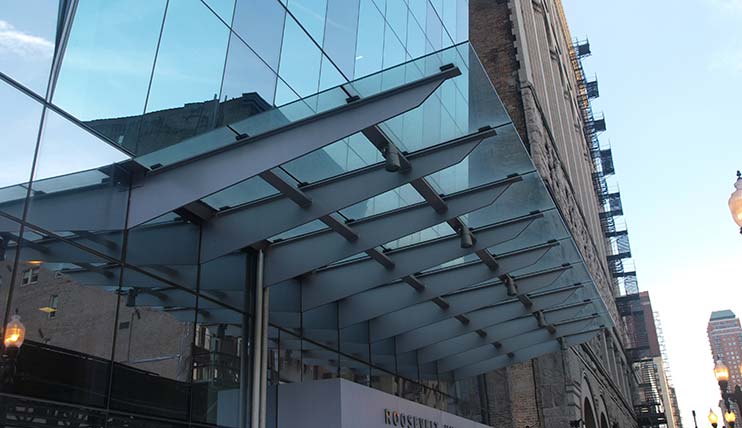
One of the most common questions about glass canopy design is the correct slope at which to specify the glass. The traditional recommendation (at least 15 degrees) is often not heeded, for aesthetic design reasons.
The 15 degree rule has been in place for years on nearly all sloped glass applications, whether they are skylights, canopies, or other structures. The primary reason for a 15 degree slope comes down simply to efficient water runoff:
- Slopes less than 15 degrees don’t move water as well as steeper slopes.
- Flatter glass can tend to deflect under its own weight, and can create “ponding” from standing water that remains to evaporate in its slightly convex shape. Once the water evaporates, a dust residue can remain on the glass.
So do we build canopies with shallow, or nearly flat slopes? Yes, all the time, as long as the following design strategies are taken into account:
- Engineer and specify a glass thickness that will not deflect greatly, based on the largest lite size.
- Consider glass anchoring locations that help to manage deflection (more point supports, or continuous rafter support can stiffen the lites).
- Consider a stiffer interlayer in the glass make-up, such as an SGP to stiffen the glass. SGP can also keep required glass thickness down.
- Factor regular cleanings into the ongoing maintenance plan for the canopy.
- Consider a frit pattern or semi-opaque interlayer on the glass make-up to obscure any residual dust and debris.
Relatively flat glass can, and is, regularly incorporated into sloped glazing applications. It can be designed to be incredibly strong to meet structural requirements, but it does not naturally shed water in an efficient way. Correctly specifying glass make-ups to manage glass deflection, along with the creation of a regular maintenance plan, will guarantee that the canopy continues to look as good as it was originally designed to look.